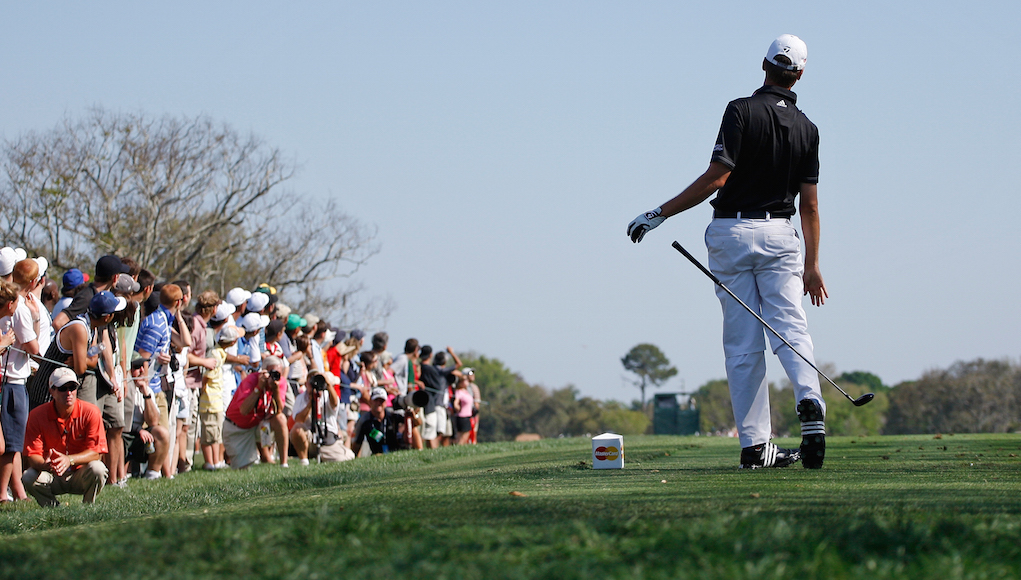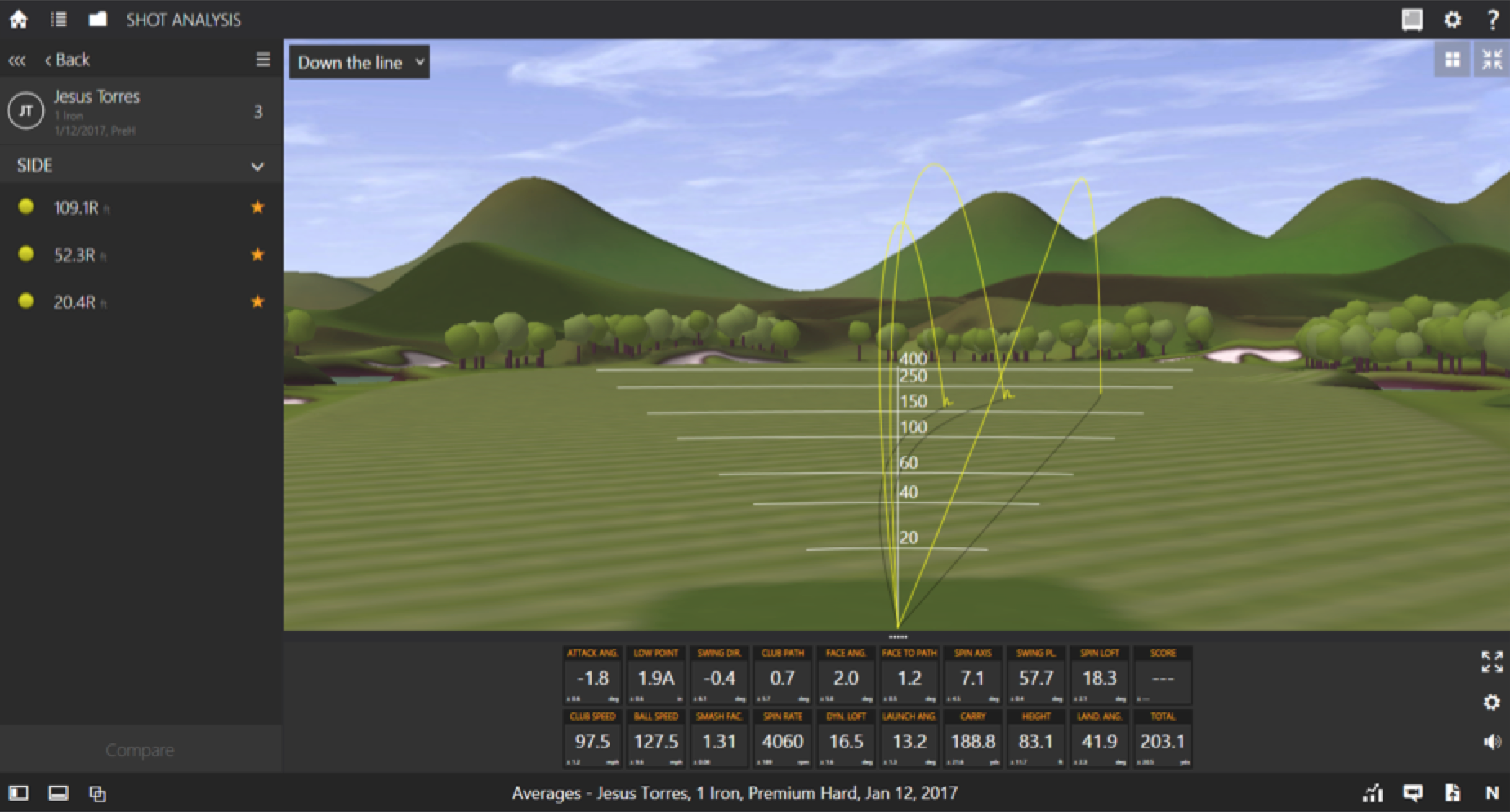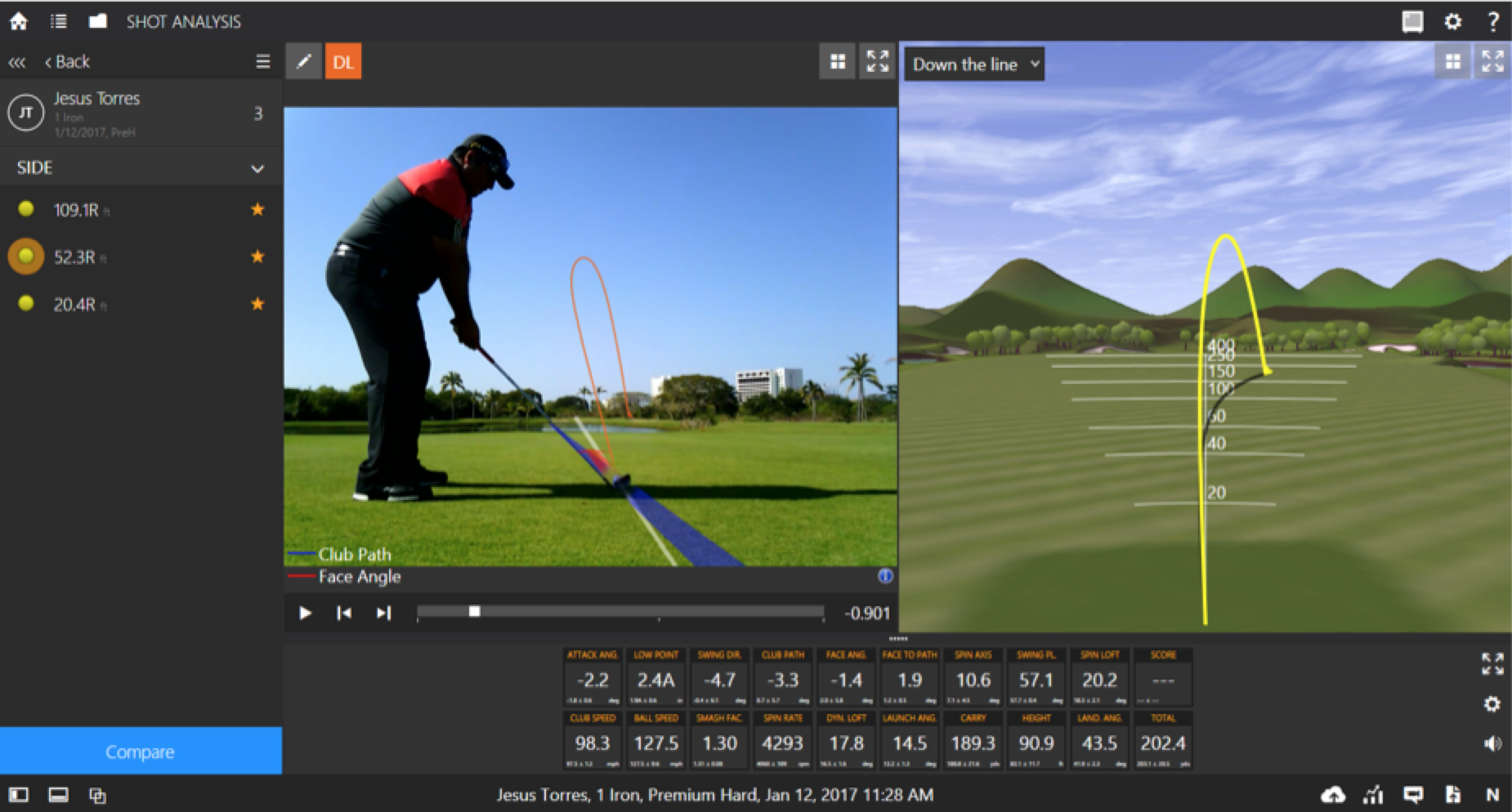Instruction
How to BEAT Your Trouble Hole

Think of your home course or a course you play often. Is there one hole that always seems to give you fits? If you’re like many golfers, there absolute is. Your memories of the hole are awful and the mental baggage keeps piling up. It’s not a good feeling, but it’s one golfers can combat with a new outlook and a bit of practice.
For the purposes of this article, I asked one of my assistant professionals, Miguel, about his “trouble hole” at Vidanta (where we work), and what his typical miss is on the hole.

His trouble hole is the one pictured above; it’s No. 17 at Vidanta, a 210-yard par-3 over water. He said he always goes way right in an effort to avoid the water, so I set up my Trackman behind the hole and asked Miguel to hit a few shots to see what happened. The Trackman numbers aren’t important here; just focus on the shot shape in the first image.

As you can see, Miguel hit each shot wide right of his target. It was clear that his mental block was making him uncomfortable on the tee, which made him block the ball to the right.
From a technical standpoint, you can see his swing path (the blue line in the image below) is left of his target and his face angle (shown in red) is right of the path, causing his slice. Couple this with years of bad memories, and you have a serious issue.

So what’s the secret to getting over your mental block on your trouble hole? You need to cross the wires by doing something radically different during your practice sessions until you develop a repeatable shot. Then when you step on the tee your next time out, you have good memories and a new shot to rely on.
Miguel tends to move the ball left to right normally, so I had him hit a few draws into the pin to help him see the hole differently. At first, we didn’t care where the ball landed. Our only goal was to get the ball to move away from the right side, so it was OK when Miguel hit a few in the water. After several tries his path shifted to the right and his club face was gently left of the path, which created a draw. Miguel’s confidence started to increase, and after while it becomes easier for him to make a normal swing at the target.
The next time you step up to your trouble hole or go to the range, try doing something completely different… maybe you want to try working the ball a different direction or take a drastically different line off the tee. Attack the hole instead of letting the hole attack you.
Best of luck in beating down your demons!
Instruction
The Wedge Guy: Beating the yips into submission

There may be no more painful affliction in golf than the “yips” – those uncontrollable and maddening little nervous twitches that prevent you from making a decent stroke on short putts. If you’ve never had them, consider yourself very fortunate (or possibly just very young). But I can assure you that when your most treacherous and feared golf shot is not the 195 yard approach over water with a quartering headwind…not the extra tight fairway with water left and sand right…not the soft bunker shot to a downhill pin with water on the other side…No, when your most feared shot is the remaining 2- 4-foot putt after hitting a great approach, recovery or lag putt, it makes the game almost painful.
And I’ve been fighting the yips (again) for a while now. It’s a recurring nightmare that has haunted me most of my adult life. I even had the yips when I was in my 20s, but I’ve beat them into submission off and on most of my adult life. But just recently, that nasty virus came to life once again. My lag putting has been very good, but when I get over one of those “you should make this” length putts, the entire nervous system seems to go haywire. I make great practice strokes, and then the most pitiful short-stroke or jab at the ball you can imagine. Sheesh.
But I’m a traditionalist, and do not look toward the long putter, belly putter, cross-hand, claw or other variation as the solution. My approach is to beat those damn yips into submission some other way. Here’s what I’m doing that is working pretty well, and I offer it to all of you who might have a similar affliction on the greens.
When you are over a short putt, forget the practice strokes…you want your natural eye-hand coordination to be unhindered by mechanics. Address your putt and take a good look at the hole, and back to the putter to ensure good alignment. Lighten your right hand grip on the putter and make sure that only the fingertips are in contact with the grip, to prevent you from getting to tight.
Then, take a long, long look at the hole to fill your entire mind and senses with the target. When you bring your head/eyes back to the ball, try to make a smooth, immediate move right into your backstroke — not even a second pause — and then let your hands and putter track right back together right back to where you were looking — the HOLE! Seeing the putter make contact with the ball, preferably even the forward edge of the ball – the side near the hole.
For me, this is working, but I am asking all of you to chime in with your own “home remedies” for the most aggravating and senseless of all golf maladies. It never hurts to have more to fall back on!
Instruction
Looking for a good golf instructor? Use this checklist

Over the last couple of decades, golf has become much more science-based. We measure swing speed, smash factor, angle of attack, strokes gained, and many other metrics that can really help golfers improve. But I often wonder if the advancement of golf’s “hard” sciences comes at the expense of the “soft” sciences.
Take, for example, golf instruction. Good golf instruction requires understanding swing mechanics and ball flight. But let’s take that as a given for PGA instructors. The other factors that make an instructor effective can be evaluated by social science, rather than launch monitors.
If you are a recreational golfer looking for a golf instructor, here are my top three points to consider.
1. Cultural mindset
What is “cultural mindset? To social scientists, it means whether a culture of genius or a culture of learning exists. In a golf instruction context, that may mean whether the teacher communicates a message that golf ability is something innate (you either have it or you don’t), or whether golf ability is something that can be learned. You want the latter!
It may sound obvious to suggest that you find a golf instructor who thinks you can improve, but my research suggests that it isn’t a given. In a large sample study of golf instructors, I found that when it came to recreational golfers, there was a wide range of belief systems. Some instructors strongly believed recreational golfers could improve through lessons. while others strongly believed they could not. And those beliefs manifested in the instructor’s feedback given to a student and the culture created for players.
2. Coping and self-modeling can beat role-modeling
Swing analysis technology is often preloaded with swings of PGA and LPGA Tour players. The swings of elite players are intended to be used for comparative purposes with golfers taking lessons. What social science tells us is that for novice and non-expert golfers, comparing swings to tour professionals can have the opposite effect of that intended. If you fit into the novice or non-expert category of golfer, you will learn more and be more motivated to change if you see yourself making a ‘better’ swing (self-modeling) or seeing your swing compared to a similar other (a coping model). Stay away from instructors who want to compare your swing with that of a tour player.
3. Learning theory basics
It is not a sexy selling point, but learning is a process, and that process is incremental – particularly for recreational adult players. Social science helps us understand this element of golf instruction. A good instructor will take learning slowly. He or she will give you just about enough information that challenges you, but is still manageable. The artful instructor will take time to decide what that one or two learning points are before jumping in to make full-scale swing changes. If the instructor moves too fast, you will probably leave the lesson with an arm’s length of swing thoughts and not really know which to focus on.
As an instructor, I develop a priority list of changes I want to make in a player’s technique. We then patiently and gradually work through that list. Beware of instructors who give you more than you can chew.
So if you are in the market for golf instruction, I encourage you to look beyond the X’s and O’s to find the right match!
Instruction
What Lottie Woad’s stunning debut win teaches every golfer

Most pros take months, even years, to win their first tournament. Lottie Woad needed exactly four days.
The 21-year-old from Surrey shot 21-under 267 at Dundonald Links to win the ISPS Handa Women’s Scottish Open by three shots — in her very first event as a professional. She’s only the third player in LPGA history to accomplish this feat, joining Rose Zhang (2023) and Beverly Hanson (1951).
But here’s what caught my attention as a coach: Woad didn’t win through miraculous putting or bombing 300-yard drives. She won through relentless precision and unshakeable composure. After watching her performance unfold, I’m convinced every golfer — from weekend warriors to scratch players — can steal pages from her playbook.
Precision Beats Power (And It’s Not Even Close)
Forget the driving contests. Woad proved that finding greens matters more than finding distance.
What Woad did:
• Hit it straight, hit it solid, give yourself chances
• Aimed for the fat parts of greens instead of chasing pins
• Let her putting do the talking after hitting safe targets
• As she said, “Everyone was chasing me today, and managed to maintain the lead and played really nicely down the stretch and hit a lot of good shots”
Why most golfers mess this up:
• They see a pin tucked behind a bunker and grab one more club to “go right at it”
• Distance becomes more important than accuracy
• They try to be heroic instead of smart
ACTION ITEM: For your next 10 rounds, aim for the center of every green regardless of pin position. Track your greens in regulation and watch your scores drop before your swing changes.
The Putter That Stayed Cool Under Fire
Woad started the final round two shots clear and immediately applied pressure with birdies at the 2nd and 3rd holes. When South Korea’s Hyo Joo Kim mounted a charge and reached 20-under with a birdie at the 14th, Woad didn’t panic.
How she responded to pressure:
• Fired back with consecutive birdies at the 13th and 14th
• Watched Kim stumble with back-to-back bogeys
• Capped it with her fifth birdie of the day at the par-5 18th
• Stayed patient when others pressed, pressed when others cracked
What amateurs do wrong:
• Get conservative when they should be aggressive
• Try to force magic when steady play would win
• Panic when someone else makes a move
ACTION ITEM: Practice your 3-6 foot putts for 15 minutes after every range session. Woad’s putting wasn’t spectacular—it was reliable. Make the putts you should make.
Course Management 101: Play Your Game, Not the Course’s Game
Woad admitted she couldn’t see many scoreboards during the final round, but it didn’t matter. She stuck to her game plan regardless of what others were doing.
Her mental approach:
• Focused on her process, not the competition
• Drew on past pressure situations (Augusta National Women’s Amateur win)
• As she said, “That was the biggest tournament I played in at the time and was kind of my big win. So definitely felt the pressure of it more there, and I felt like all those experiences helped me with this”
Her physical execution:
• 270-yard drives (nothing flashy)
• Methodical iron play
• Steady putting
• Everything effective, nothing spectacular
ACTION ITEM: Create a yardage book for your home course. Know your distances to every pin, every hazard, every landing area. Stick to your plan no matter what your playing partners are doing.
Mental Toughness Isn’t Born, It’s Built
The most impressive part of Woad’s win? She genuinely didn’t expect it: “I definitely wasn’t expecting to win my first event as a pro, but I knew I was playing well, and I was hoping to contend.”
Her winning mindset:
• Didn’t put winning pressure on herself
• Focused on playing well and contending
• Made winning a byproduct of a good process
• Built confidence through recent experiences:
- Won the Women’s Irish Open as an amateur
- Missed a playoff by one shot at the Evian Championship
- Each experience prepared her for the next
What this means for you:
• Stop trying to shoot career rounds every time you tee up
• Focus on executing your pre-shot routine
• Commit to every shot
• Stay present in the moment
ACTION ITEM: Before each round, set process goals instead of score goals. Example: “I will take three practice swings before every shot” or “I will pick a specific target for every shot.” Let your score be the result, not the focus.
The Real Lesson
Woad collected $300,000 for her first professional victory, but the real prize was proving that fundamentals still work at golf’s highest level. She didn’t reinvent the game — she simply executed the basics better than everyone else that week.
The fundamentals that won:
• Hit more fairways
• Find more greens
• Make the putts you should make
• Stay patient under pressure
That’s something every golfer can do, regardless of handicap. Lottie Woad just showed us it’s still the winning formula.
FINAL ACTION ITEM: Pick one of the four action items above and commit to it for the next month. Master one fundamental before moving to the next. That’s how champions are built.
PGA Professional Brendon Elliott is an award-winning coach and golf writer. You can check out his writing work and learn more about him by visiting BEAGOLFER.golf and OneMoreRollGolf.com. Also, check out “The Starter” on RG.org each Monday.
Editor’s note: Brendon shares his nearly 30 years of experience in the game with GolfWRX readers through his ongoing tip series. He looks forward to providing valuable insights and advice to help golfers improve their game. Stay tuned for more Tips!










Dave
Jan 23, 2017 at 11:14 am
Internet winner!!!
Ron
Jan 23, 2017 at 9:50 am
For me, my trouble hole is our #3 hole, with unplayable water and waste area all down the right side, and a fairway that pitches slightly from left to right, to allow better drainage. My tee ball isn’t the problem. It is the approach to the narrow green. My last thought over the ball tends to be ‘don’t hit it right’. So, naturally, I hit it into the crap almost every time. When I don’t, I wind of left of the green, and then blade my chip over the green into the crap. No matter what, the junk on the right of the hole is getting one of my balls. So, the entire problem, on both those shots, is lack of confidence. If I could be aggressive on the approach and fire through the ball, I’d be in better shape. If I was aggressive on the chip instead of hesitant, I wouldn’t short-arm it into the weeds. But my experience on the hole feeds my tentative swings, making everything worse.
Philip
Jan 22, 2017 at 11:21 pm
Before I would go about creating a new shot for a troublesome hole (unless I wanted to add the shot to my bag), I would just play the hole differently. Play the par 3 in 2 instead of going for the green if I do not have the confidence. Or instead of driver go with a lot less to get the ball on the fairway and then play a lower iron for the second shot, or even turn it into a deliberate par save with three shots to get on the green. The 3rd shot should be close enough to really increase my chances of the par save.
Mindless
Jan 21, 2017 at 9:50 pm
Instead of telling your readers to go thru their routine, for ex; narrow your target, check alignment, and so on. You want them to completely go against what they do normally and or naturally. Most don’t have access to trackman let alone trying something foreign. Trust in what you do the best advice from my instructor, Mike Bender…
chinchbugs
Jan 21, 2017 at 7:35 pm
Can I borrow your trackman to work on my trouble hole?
Alfredo Smith
Jan 21, 2017 at 1:51 pm
Love this article Tom! For my difficult hole #9, at Metropolitan GC in Oakland, I put the driver away and hit a long iron off the tee, it gives me a longer shot into the green but it’s better than hitting from the drop area (for 5 plus rounds in a row) it is hard to accept that a hole is in your head (the muy macho effect) but you have to face the truth and deal with it. The key for me was changing things up just like your article!